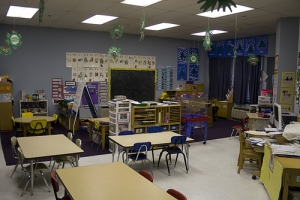The Physical Environment

The physical environment of a classroom influences the behavior of students. The design of the classroom should exude production. Teachers need to provide a plan that helps students develop personal identity, encourage feeling of competence and security, promotes intellectual stimulation and growth, and allows for privacy when desired. The spatial dimensions of the classroom helps teachers with these goals. Spatial dimensions include seating arrangements, teacher proximity to students, teacher movement around the space, and ambiance. According to Jones (2007), "The optimal room arrangement allows you to get from any student to any other student with the fewest steps" (p. 47).
The Physical Environment Checklist
The following is a list of traits that a good classroom should have in it's physical environment. After reading the list (Savage, 1999, p. 75), see if you can spot any of these traits in the video of a kindergarten classroom.
High traffic areas are free of congestion.
Placement of student desks communicates the desired interaction pattern and teaching approach.
Teacher’s desk is in an unobtrusive area.
High traffic areas are free of obstruction.
The teacher can gain easy access to all students.
Students can clearly see instructional stations.
Frequently used material is accessible.
The equipment and furnishings are appropriate for the age of the students.
Room arrangement allows for some privacy.
The classroom ambiance creates a pleasant yet businesslike environment.
There is sensory stimulation.
There is evidence of personalizing and softening the environment.
The classroom is attractive and creates a good, comfortable, and secure feeling.
There are definite areas and boundaries for different activities.
Job 11:18 You will be secure, because there is hope; you will look about you and take your rest in safety. (NIV)
This passage represents the feeling of comfort and security I would want my students to experience as they come through my classroom each year. In order for students to learn and retain what they have learned, they need to feel secure, comfortable, relaxed, and have someone reassure them of their successes.
HOME; management and discipline defined; visual instruction plans; the physical environment; authority and leadership; proximity and mobility; praise, promt, and leave; say, see, do teaching; calm and consistency; time management; preferred activity time; references